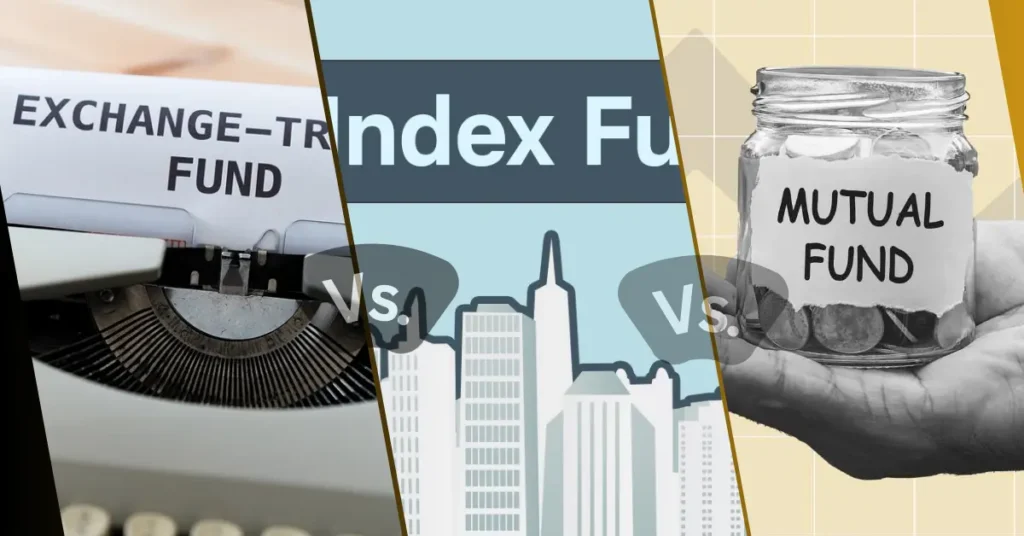Key Differences Between ETF, Index Fund, and Mutual Fund
1. Trading Flexibility:
- ETF (Exchange-Traded Fund): One of the main advantages of ETFs is their trading flexibility.
ETFs are listed on stock exchanges, which means they can be bought and sold throughout the trading day at market prices, just like individual stocks.
This allows investors to take advantage of intraday price fluctuations, enabling them to respond quickly to market conditions.
For example, if an investor believes the market will decline later in the day, they can sell their ETF shares at any time during market hours.
- Index Fund: Index funds, on the other hand, are typically structured as mutual funds and are not traded on exchanges.
Instead, they can only be bought or sold at the end of the trading day at the net asset value (NAV), which is calculated after the market closes.
This means investors cannot take advantage of intraday market movements, as all buy and sell orders are executed at the same price at the end of the day.
- Mutual Fund: Similar to index funds, traditional mutual funds also trade at the end of the trading day based on their NAV.
Investors submit buy or sell orders throughout the day, but these orders are executed only after the market closes.
This lack of intraday trading flexibility can limit an investor’s ability to react quickly to market changes, particularly in volatile markets.
2. Management Style:
- ETF: Most ETFs are passively managed, meaning they aim to replicate the performance of a specific index or benchmark, such as the Nifty 50 or S&P 500.
The goal is to match the index’s performance rather than trying to outperform it. However, there are also actively managed ETFs where fund managers make investment decisions to try to generate higher returns, but these are less common.
- Index Fund: Index funds are also passively managed and are designed to track the performance of a particular index.
This passive management approach generally leads to lower costs, as there are fewer trades and less research involved compared to actively managed funds.
For example, a Sensex index fund will invest in the same stocks that comprise the Sensex Index in the same proportions, providing broad market exposure.
- Mutual Fund: Traditional mutual funds can be either actively or passively managed. Actively managed mutual funds have fund managers who make investment decisions based on research and market analysis, aiming to outperform a benchmark index.
This active management can lead to higher potential returns but also incurs higher management fees and costs due to frequent trading and research expenses.
Conversely, passively managed mutual funds aim to replicate an index’s performance, similar to index funds.
3. Fees and Expenses:
- ETF: ETFs usually have lower expense ratios compared to actively managed mutual funds.
Since most ETFs are passively managed, the operational costs are generally lower.
However, investors must also consider brokerage commissions when buying or selling ETFs, which can add to the total cost, especially for those who trade frequently.
- Index Fund: Index funds typically have lower fees than actively managed mutual funds, as they do not require extensive research or management.
However, they may still have management fees, though these are often significantly lower than those of actively managed funds. Investors benefit from the lower expense ratios, which can lead to higher net returns over time.
- Mutual Fund: Actively managed mutual funds usually have higher expense ratios due to the costs associated with active management, including management fees, research expenses, and trading costs.
This can impact the overall returns for investors, especially if the fund fails to outperform its benchmark.
It is essential for investors to consider these fees when evaluating mutual funds, as high costs can erode investment gains over time.
4. Liquidity:
- ETF: ETFs offer greater liquidity since they can be traded throughout the day. This feature allows investors to execute trades at current market prices, making it easier to enter or exit positions as needed.
Investors can also set limit orders to buy or sell shares at specific prices, providing additional control over trading.
- Index Fund: Index funds do not offer the same level of liquidity as ETFs. Since they are traded at the end of the day, investors may face delays in executing trades, which could result in missed opportunities during volatile market conditions.
Investors should also be aware that the price at which they buy or sell an index fund may not reflect real-time market conditions.
- Mutual Fund: Similar to index funds, traditional mutual funds also have limited liquidity due to their end-of-day trading structure.
This can be a disadvantage for investors looking for quick access to their funds or those wanting to react promptly to market changes.
However, some mutual funds may allow for automatic redemption or withdrawals, which can offer some level of convenience.
Conclusion
In summary, while ETFs, index funds, and mutual funds share some similarities, they differ significantly in trading flexibility, management style, fees, and liquidity.
Each option has its advantages and drawbacks, making it essential for investors to evaluate their individual investment goals, risk tolerance, and preferences when choosing among them.
Understanding these key differences can help investors make informed decisions that align with their financial objectives.
Here’s a comparison of ETFs, index funds, and mutual funds presented in table form:
| Feature | ETF (Exchange-Traded Fund) | Index Fund | Mutual Fund |
| Trading Flexibility | Traded on stock exchanges; can be bought/sold throughout the day. | Bought/sold at the end of the trading day at NAV. | Similar to index funds; traded at the end of the trading day at NAV. |
| Management Style | Mostly passively managed, but some are actively managed. | Passively managed; aims to replicate a specific index. | Can be actively or passively managed; actively managed funds aim to outperform a benchmark. |
| Fees and Expenses | Generally lower expense ratios; may incur brokerage fees. | Lower fees than actively managed mutual funds; management fees apply. | Typically higher fees due to active management; management fees and expenses apply. |
| Liquidity | High liquidity; trades at market prices throughout the day. | Lower liquidity; trades at end-of-day NAV. | Similar to index funds; lower liquidity; trades at end-of-day NAV. |
| Investment Control | It can be actively or passively managed; actively managed funds aim to outperform a benchmark. | Price reflects end-of-day market conditions; limited control. | Price reflects end-of-day market conditions; limited control. |
| Example | Nifty 50 ETF tracks the Nifty 50 Index. | Sensex index fund mirrors the performance of the Sensex. | Large-cap equity mutual fund focuses on high-growth companies. |
Also, Read–
1. Basic Stock Market Terms
2. ‘Types of Stocks, Securities and Investment Instruments’ Related terms



